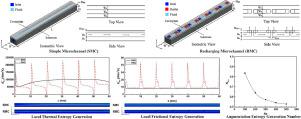当前位置:
X-MOL 学术
›
Int. J. Mech. Sci.
›
论文详情
Our official English website, www.x-mol.net, welcomes your
feedback! (Note: you will need to create a separate account there.)
Second Law Analysis of Recharging Microchannel using Entropy Generation Minimization Method
International Journal of Mechanical Sciences ( IF 7.1 ) Pub Date : 2021-03-01 , DOI: 10.1016/j.ijmecsci.2020.106174 Sangram Kumar Samal , Manoj Kumar Moharana
International Journal of Mechanical Sciences ( IF 7.1 ) Pub Date : 2021-03-01 , DOI: 10.1016/j.ijmecsci.2020.106174 Sangram Kumar Samal , Manoj Kumar Moharana

|
Abstract This work deals with numerical study of entropy generation in recharging and simple microchannel to explore effect of geometrical modification on thermodynamic irreversibility in a system. This work also investigates effects of geometrical and thermo-physical parameters on entropy generation in recharging microchannel system, by varying number of small channels, substrate thickness, channel wall width, channel aspect ratio, substrate material, and applied heat flux. Numerical simulations are carried out by considering water as working fluid with Reynolds number 100-500. Results reveal that recharging microchannel shows maximum 47% reduction in total entropy generation compared to simple microchannel, which indicates that thermodynamic irreversibility is lower in recharging microchannel compared to simple microchannel. Thermal entropy generation in recharging microchannel decreases with increasing number of small channels, channel aspect ratio, and substrate material thermal conductivity, whereas it increases with increasing substrate thickness, channel wall width, and applied heat flux. Moreover, frictional entropy generation in recharging microchannel is invariant with substrate thickness, channel wall width, substrate material, and applied heat flux. These parametric investigations indicate that consideration of entropy generation in microchannel solid substrate during entropy generation analysis is quite important, as it strongly influence entropy generation in a system.
中文翻译:

使用熵产生最小化方法对充电微通道进行第二定律分析
摘要 这项工作涉及再充电和简单微通道中熵产生的数值研究,以探讨几何修改对系统热力学不可逆性的影响。这项工作还通过改变小通道数量、基底厚度、通道壁宽、通道纵横比、基底材料和施加的热通量,研究几何和热物理参数对再充电微通道系统中熵产生的影响。将水作为雷诺数为 100-500 的工作流体进行数值模拟。结果表明,与简单微通道相比,再充电微通道的总熵产生最大减少了 47%,这表明与简单微通道相比,再充电微通道的热力学不可逆性较低。再充电微通道中的热熵产生随着小通道数量、通道纵横比和基底材料热导率的增加而减少,而它随着基底厚度、通道壁宽和施加的热通量的增加而增加。此外,再充电微通道中摩擦熵的产生与基底厚度、通道壁宽、基底材料和施加的热通量无关。这些参数研究表明,在熵生成分析过程中考虑微通道固体基质中的熵生成非常重要,因为它强烈影响系统中的熵生成。而它随着基板厚度、通道壁宽和施加的热通量的增加而增加。此外,再充电微通道中摩擦熵的产生与基底厚度、通道壁宽、基底材料和施加的热通量无关。这些参数研究表明,在熵生成分析过程中考虑微通道固体基质中的熵生成非常重要,因为它强烈影响系统中的熵生成。而它随着基板厚度、通道壁宽和施加的热通量的增加而增加。此外,再充电微通道中摩擦熵的产生与基底厚度、通道壁宽、基底材料和施加的热通量无关。这些参数研究表明,在熵生成分析过程中考虑微通道固体基质中的熵生成非常重要,因为它强烈影响系统中的熵生成。
更新日期:2021-03-01
中文翻译:

使用熵产生最小化方法对充电微通道进行第二定律分析
摘要 这项工作涉及再充电和简单微通道中熵产生的数值研究,以探讨几何修改对系统热力学不可逆性的影响。这项工作还通过改变小通道数量、基底厚度、通道壁宽、通道纵横比、基底材料和施加的热通量,研究几何和热物理参数对再充电微通道系统中熵产生的影响。将水作为雷诺数为 100-500 的工作流体进行数值模拟。结果表明,与简单微通道相比,再充电微通道的总熵产生最大减少了 47%,这表明与简单微通道相比,再充电微通道的热力学不可逆性较低。再充电微通道中的热熵产生随着小通道数量、通道纵横比和基底材料热导率的增加而减少,而它随着基底厚度、通道壁宽和施加的热通量的增加而增加。此外,再充电微通道中摩擦熵的产生与基底厚度、通道壁宽、基底材料和施加的热通量无关。这些参数研究表明,在熵生成分析过程中考虑微通道固体基质中的熵生成非常重要,因为它强烈影响系统中的熵生成。而它随着基板厚度、通道壁宽和施加的热通量的增加而增加。此外,再充电微通道中摩擦熵的产生与基底厚度、通道壁宽、基底材料和施加的热通量无关。这些参数研究表明,在熵生成分析过程中考虑微通道固体基质中的熵生成非常重要,因为它强烈影响系统中的熵生成。而它随着基板厚度、通道壁宽和施加的热通量的增加而增加。此外,再充电微通道中摩擦熵的产生与基底厚度、通道壁宽、基底材料和施加的热通量无关。这些参数研究表明,在熵生成分析过程中考虑微通道固体基质中的熵生成非常重要,因为它强烈影响系统中的熵生成。











































 京公网安备 11010802027423号
京公网安备 11010802027423号